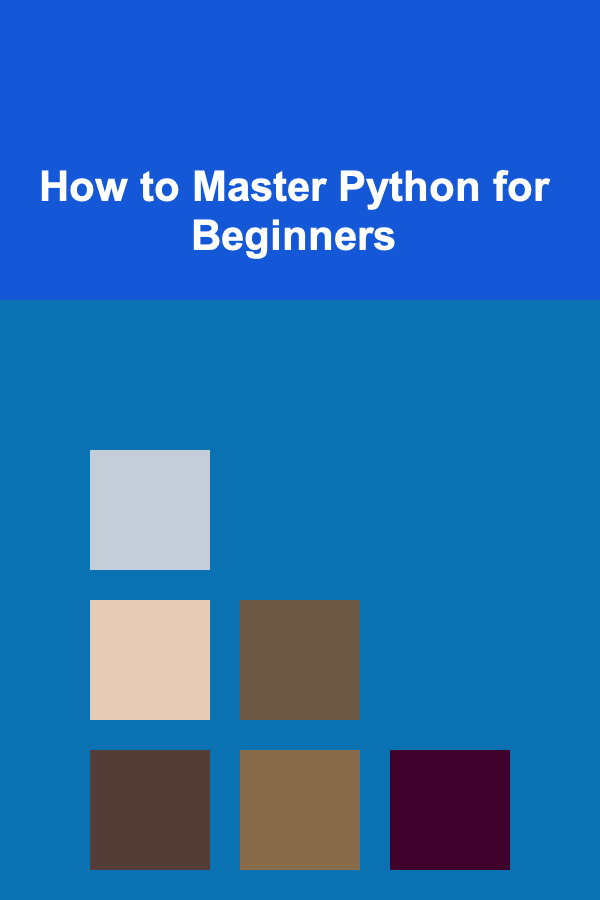
How to Master Python for Beginners
ebook include PDF & Audio bundle (Micro Guide)
$12.99$10.99
Limited Time Offer! Order within the next:

Python is one of the most widely used and accessible programming languages in the world. From data science to web development, and from automation to artificial intelligence, Python is at the core of many modern technologies. If you're a beginner looking to master Python, you're about to embark on an exciting journey. Python's simplicity and readability make it an excellent choice for anyone looking to start their programming career.
In this article, we will guide you through how to master Python step-by-step, from the very basics to more advanced concepts, helping you build a strong foundation in programming and problem-solving. We will cover everything from installation, syntax, and essential libraries, to object-oriented programming (OOP) and web development.
Getting Started with Python
Before diving into the details of Python, you need to install Python and set up a development environment.
1. Install Python
To get started, you need to download and install Python on your computer. Python's official website (https://www.python.org/) provides the latest version of Python. Here's a simple guide to get Python installed:
- Go to python.org.
- Download the latest version of Python (Python 3.x).
- Follow the installation instructions for your operating system.
- Ensure that Python is added to your system's PATH during installation (there's a checkbox for this during setup).
Once Python is installed, you can verify the installation by opening a terminal or command prompt and typing the following command:
If Python is installed correctly, you should see something like:
2. Set Up a Code Editor
A good code editor will make your Python learning experience more comfortable. There are many options available, but some popular ones include:
- VS Code: A powerful, lightweight editor with extensions and debugging tools.
- PyCharm: A full-fledged IDE specifically designed for Python development.
- Jupyter Notebooks: Ideal for data science and scientific computing.
VS Code and PyCharm both offer features like syntax highlighting, auto-completion, and debugging that will help you write cleaner code and debug your programs more easily.
3. Write Your First Python Program
Once Python and your editor are set up, it's time to write your first Python program. Open your editor, create a new file called hello.py, and type the following:
Save the file and run it in your terminal or command prompt by navigating to the directory where the file is located and typing:
You should see the output:
Congratulations! You've just written your first Python program. Now, let's move on to learning the fundamentals of Python programming.
Understanding Python Syntax and Basic Concepts
1. Variables and Data Types
In Python, a variable is used to store data. Python is dynamically typed, meaning you don't have to specify the data type explicitly. The data type is determined automatically based on the value assigned.
Here are some examples of different data types in Python:
age = 25
# Float
height = 5.9
# String
name = "John Doe"
# Boolean
is_student = True
Python supports several common data types such as integers, floats, strings, and booleans. These are the building blocks of any Python program.
2. Basic Operators
Python has several operators for performing operations on variables and data:
-
Arithmetic operators: Used for mathematical calculations.
y = 5 print(x + y) # Addition print(x - y) # Subtraction print(x * y) # Multiplication print(x / y) # Division -
Comparison operators: Used to compare values.
y = 5 print(x > y) # Greater than print(x < y) # Less than -
Logical operators: Used to combine conditional statements.
b = False print(a and b) # Logical AND print(a or b) # Logical OR
3. Control Flow
Control flow in Python allows you to make decisions in your programs. Python provides several statements for control flow:
-
If-else statements: Used for decision making.
if age >= 18: print("You are an adult.") else: print("You are a minor.") -
For loops: Used to iterate over a sequence (like a list or range).
print(i) -
While loops: Used to repeat a block of code as long as a condition is true.
while count < 5: print(count) count += 1
Intermediate Concepts
As you start getting comfortable with the basics of Python, it's time to learn some more intermediate concepts that will make your programs more efficient and organized.
1. Functions
A function in Python is a block of code that can be reused to perform a specific task. Functions help make code modular and easier to maintain.
Here's a simple example of a function in Python:
print(f"Hello, {name}!")
greet("Alice") # Calling the function
greet("Bob")
You can also return values from functions:
return x + y
result = add(5, 3)
print(result)
2. Lists and Tuples
Lists are mutable sequences, meaning their contents can be changed. Tuples, on the other hand, are immutable, and once created, their contents cannot be modified.
Here's an example of a list and a tuple:
fruits = ["apple", "banana", "cherry"]
fruits.append("orange") # Adding an element
print(fruits)
# Tuple
coordinates = (4, 5)
print(coordinates)
3. Dictionaries
Dictionaries are key-value pairs, where each key is mapped to a value. They are unordered and mutable.
print(person["name"]) # Accessing a value by key
person["age"] = 26 # Updating a value
4. File Handling
Python allows you to read and write files. Here's how you can work with files:
with open("example.txt", "w") as file:
file.write("Hello, this is a file.")
# Reading from a file
with open("example.txt", "r") as file:
content = file.read()
print(content)
Advanced Concepts
Once you have a good grasp of the basics, you can move on to more advanced topics that will enhance your Python skills.
1. Object-Oriented Programming (OOP)
Object-Oriented Programming (OOP) is a programming paradigm based on the concept of objects, which contain data and methods to manipulate that data. Python is an object-oriented language, and mastering OOP is crucial for writing more organized and maintainable code.
Here's a basic example of a class and objects in Python:
def __init__(self, make, model):
self.make = make
self.model = model
def display_info(self):
print(f"{self.make} {self.model}")
# Creating an object of the class
car1 = Car("Toyota", "Corolla")
car1.display_info()
In the example above, the class Car has attributes (make, model) and a method (display_info).
2. Python Libraries and Frameworks
Python has an extensive ecosystem of libraries and frameworks that make it easier to perform complex tasks. Some of the most popular libraries include:
- NumPy and Pandas for data analysis.
- Matplotlib and Seaborn for data visualization.
- Django and Flask for web development.
- TensorFlow and PyTorch for machine learning.
Mastering these libraries will open up a wide range of opportunities in different fields like data science, web development, and AI.
3. Web Development with Python
Python is widely used in web development. Frameworks like Django and Flask allow you to build powerful web applications efficiently.
Here's an example of a simple Flask application:
app = Flask(__name__)
@app.route('/')
def hello_world():
return "Hello, World!"
if __name__ == "__main__":
app.run()
To run the application, save the code in a file called app.py, and run it using:
This will start a local server, and you can view your web application by visiting http://localhost:5000 in your browser.
4. Data Science and Machine Learning
Python is the go-to language for data science and machine learning. With libraries like NumPy, Pandas, and Scikit-learn, you can easily manipulate data, build models, and analyze results.
Here's a simple example of using Scikit-learn to build a machine learning model:
from sklearn.linear_model import LinearRegression
import numpy as np
# Example data
X = np.array([[1], [2], [3], [4], [5]])
y = np.array([1, 2, 3, 4, 5])
# Train-test split
X_train, X_test, y_train, y_test = train_test_split(X, y, test_size=0.2)
# Create and train the model
model = LinearRegression()
model.fit(X_train, y_train)
# Predictions
predictions = model.predict(X_test)
print(predictions)
Conclusion
Mastering Python takes time, dedication, and consistent practice. By learning the fundamentals, exploring intermediate concepts, and diving into advanced topics like object-oriented programming, web development, and machine learning, you will be well on your way to becoming proficient in Python. The Python community is vast and supportive, and you can always find resources and libraries to help you solve problems.
To master Python:
- Start with the basics: variables, data types, operators, and control flow.
- Practice with real-world problems to build your skills.
- Learn more advanced topics like OOP, web development, and data science.
- Use Python libraries and frameworks to make your work easier and more efficient.
With patience and practice, you'll unlock the power of Python and be able to apply it to solve real-world problems, build applications, and develop new skills that will open doors in the tech world. Happy coding!
Reading More From Our Other Websites
- [Organization Tip 101] How to Create a Family Heirloom Showcase with Antiques
- [Screen Printing Tip 101] Best Affordable Alternatives to Photo‑Emulsion for One‑Off Designs
- [Home Lighting 101] How to Optimize Home Office Lighting for Productivity and Comfort
- [Organization Tip 101] How to Organize Canned Goods by Category
- [Organization Tip 101] How to Organize Your Budget During Economic Uncertainty
- [Toy Making Tip 101] From Fabric to Fun: Step-by-Step Guides to Handmade Sewing Machine Toys
- [Home Budget Decorating 101] How to Add Texture to Your Walls with Affordable Solutions
- [Home Storage Solution 101] How to Declutter and Organize Your Small Bathroom Using These Genius Storage for Small Bathrooms Hacks
- [Home Soundproofing 101] How to Create a Soundproof Playroom for Kids
- [Personal Finance Management 101] How to Use Budget Apps Effectively to Track and Control Spending

How to Create a Checklist for Building Healthy Relationships
Read More
How To Create a Smoky Eye for Any Occasion
Read MoreHow to Make a Jewelry Inventory List for Tracking Pieces
Read More
How to Screen Renters for Criminal Backgrounds and Financial Stability
Read More
How to Use Multi-Functional Furniture for Maximum Space Savings
Read More
10 Tips for Using a Health Planner to Improve Sleep Habits
Read MoreOther Products

How to Create a Checklist for Building Healthy Relationships
Read More
How To Create a Smoky Eye for Any Occasion
Read MoreHow to Make a Jewelry Inventory List for Tracking Pieces
Read More
How to Screen Renters for Criminal Backgrounds and Financial Stability
Read More
How to Use Multi-Functional Furniture for Maximum Space Savings
Read More